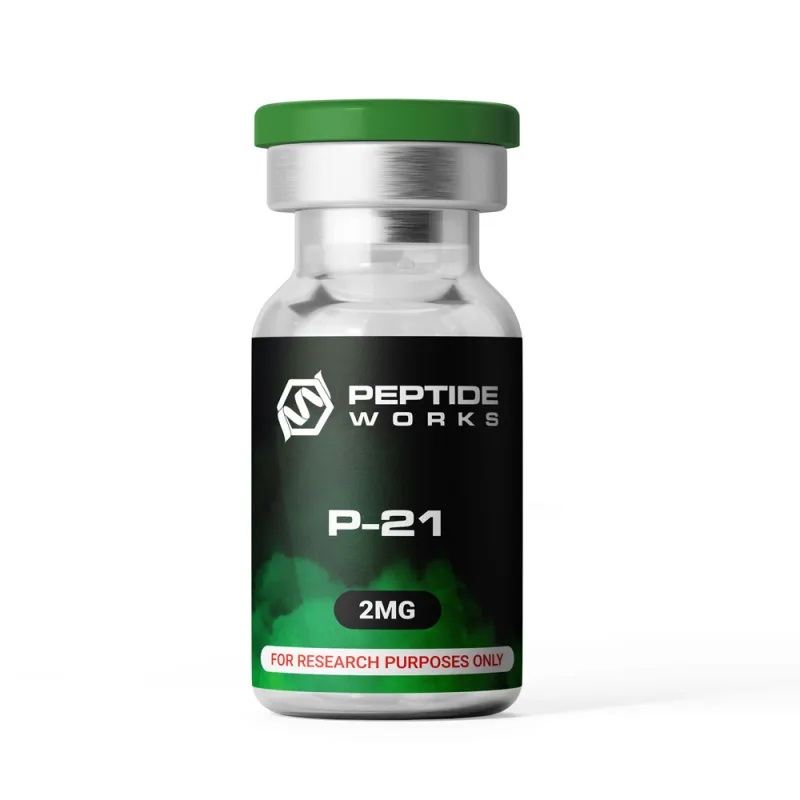
PROMO!
First order? Get 10% OFF with this code: 1storder

When it comes to peptide research, one comparison often sparks curiosity P-21 peptide vs Cerebrolysin. Both have become topics of interest for their potential roles in brain function, memory, and learning, but they could not be more different in structure.
P-21 is a synthetic peptide created with a clear, targeted design, while Cerebrolysin is a naturally derived mixture containing many compounds. This contrast raises important questions about precision versus variety in scientific study. Are researchers better served by a single defined molecule or a broad combination?
In this article, we’ll take a closer look at how these two stand apart and how the conversation naturally expands into related peptides.
Explore P-21 Peptide from Peptide Works, designed to support memory and learning pathways by boosting BDNF and protecting neurons.

One of the most important features of P-21 peptide is its ability to reach the brain. Many compounds fail at this step because the blood brain barrier blocks larger or unstable molecules. P-21 was designed differently. By attaching an adamantane group, its structure became more stable and more lipophilic, which helps it pass through this barrier with higher efficiency.
This targeted design means P-21 can deliver its effects directly where they are needed most. Crossing the blood–brain barrier is what makes it stand out from blends like Cerebrolysin, giving it a more defined role in studies of memory and learning pathways. Once inside the brain, its actions reveal even more about how it influences key processes tied to cognition.
Researchers highlight P-21 peptide for its ability to raise BDNF, a protein essential for memory and learning. It works by lowering signals that normally hold back new neuron growth. With those limits reduced, brain cells survive in greater numbers, and BDNF levels rise in areas like the hippocampus.
This sharper, single-pathway action sets P-21 apart from broad blends like Cerebrolysin. Interestingly, peptides such as PT-141 and NAD peptide also show targeted effects in their own fields. PT-141 interacts with specific receptors to guide signaling, while NAD peptide supports cellular energy balance.
Like P-21, they are valued in research because each delivers focused activity instead of a diffuse mix of actions. The way these cellular changes connect to memory outcomes provides another point of comparison.
Discover PT-141 from Peptide Works, a peptide known for targeting melanocortin receptors to influence signaling and functional balance.

Research shows that P-21 peptide improves memory by protecting synapses and enhancing signaling in the hippocampus, the brain’s key memory hub. It works through defined pathways linked to BDNF, which helps explain consistent gains in tasks measuring recall and learning. Its action follows a defined pathway, making outcomes clearer and simpler to analyze.
Cerebrolysin, on the other hand, is a mixture of many peptides and neurotrophic factors. Because of its complexity, Cerebrolysin can produce uneven outcomes. One part of the mix may drive improvement, while another adds little, which makes the results harder to follow.
P-21, on the other hand, is viewed as more targeted in memory studies. The shifting nature of Cerebrolysin also raises ongoing questions about how consistent its research findings really are.
Cerebrolysin results often differ because research does not always follow the same design. Some studies focus on Alzheimer’s, others on vascular decline or stroke, and each measures outcomes in different ways. Variations in dose levels, study length, and testing standards make it difficult to line up results across trials.
Another issue is the product itself. Cerebrolysin is a mix of peptides and neurotrophic factors. Since it is a blend, the balance of those components can change, and that can make its effects less predictable. In contrast, P-21 peptide works through one clear pathway, which helps explain why findings tend to look more consistent in controlled settings.
This difference becomes clearer when both are compared in broader neurodegenerative research.
P-21 peptide has been shown in research to reduce tau and beta-amyloid buildup, two hallmarks of Alzheimer’s disease models. It also raises BDNF, supports synapse health, and improves memory scores in controlled studies. These effects suggest a clear, targeted role in slowing neurodegenerative changes.
Cerebrolysin is explored in Alzheimer’s, vascular decline, and stroke, but outcomes are mixed. Its wide range of peptides activates many pathways, which can blur results and make them harder to reproduce. This contrast highlights why P-21 is often seen as more predictable in neurodegenerative research. Among those conditions, stroke recovery has received particular attention with Cerebrolysin.
Comparison Table
| Feature | P-21 Peptide | Cerebrolysin |
|---|---|---|
| Main Focus | Tau & amyloid reduction, BDNF boost | Broad neurotrophic activity |
| Research Consistency | Clear, repeatable findings | Mixed, varies by condition |
| Disease Models | Alzheimer’s mouse studies | Alzheimer’s, vascular dementia, stroke |

Studies on Cerebrolysin show that it may support recovery when given soon after a stroke, especially alongside rehabilitation. Research points to gains in motor function and daily activities, with some trials noting stronger effects in people with more severe ischemic stroke. These benefits are thought to come from its ability to enhance neuroplasticity and protect neurons under stress.
By contrast, P-21 peptide has not yet been tested in stroke models. Its role is clearer in Alzheimer’s research, where it reduces tau and amyloid while boosting BDNF. Whether those same pathways could aid stroke recovery remains an open question, making Cerebrolysin the more studied option in this area.
Looking beyond current findings, both peptides continue to attract interest for what they might reveal about the future of brain research.
The study of P-21 peptide and Cerebrolysin continues to reveal different ways peptides may shape brain research. P-21 offers a precise pathway with consistent results in models of memory and neurodegeneration, while Cerebrolysin reflects a broader but less predictable mix that still holds interest in stroke and recovery studies.
Both peptides contribute in their own way, showing why it is important to study them from different angles. At Peptide Works, we back this progress by supplying trusted research peptides with worldwide shipping, helping researchers choose what fits their work and continue moving science forward.
All peptides and compounds mentioned are strictly for research purposes only and not for human use.
[1] Xue LX, Zhang T, Zhao YW, Geng Z, Chen JJ, Chen H. Efficacy and safety comparison of DL-3-n-butylphthalide and Cerebrolysin: Effects on neurological and behavioral outcomes in acute ischemic stroke. Exp Ther Med. 2016 May;11(5):2015-2020.
[2] Amiri-Nikpour MR, Nazarbaghi S, Ahmadi-Salmasi B, Mokari T, Tahamtan U, Rezaei Y. Cerebrolysin effects on neurological outcomes and cerebral blood flow in acute ischemic stroke. Neuropsychiatr Dis Treat. 2014 Dec 3;10:2299-306.
[3] Mikecin AM, Walker LR, Kuna M, Raucher D. Thermally targeted p21 peptide enhances bortezomib cytotoxicity in androgen-independent prostate cancer cell lines. Anticancer Drugs. 2014 Feb;25(2):189-99.
[4] Pincus MR, Lin B, Patel P, Gabutan E, Zohar N, Bowne WB. Peptides That Block RAS-p21 Protein-Induced Cell Transformation. Biomedicines. 2023 Feb 6;11(2):471.
ALL CONTENT AND PRODUCT INFORMATION AVAILABLE ON THIS WEBSITE IS FOR EDUCATIONAL PURPOSES ONLY.
DISCLAIMER: These products are intended solely as a research chemical only. This classification allows for their use only for research development and laboratory studies. The information available on our Peptide Works website: https://peptide-works.com/ is provided for educational purposes only. These products are not for human or animal use or consumption in any manner. Handling of these products should be limited to suitably qualified professionals. They are not to be classified as a drug, food, cosmetic, or medicinal product and must not be mislabelled or used as such.
Peptide Works
Related Articles

Can Vitamin B12 Immune System Support Enhance the Effects of Thymosin Alpha-1?
The Vitamin B12 immune system link is important because this vitamin plays a crucial role in DNA synthesis, methylation, energy

What is the difference between TB500 and BPC-157 Peptides?
TB500 and BPC-157 are often compared because both appear in studies on healing and repair. Yet their roles are not

Sermorelin for Muscle Growth Over 40: Miracle or Hype?
Once people reach their 40s, building lean muscle often feels like an uphill battle. Recovery takes longer, workouts feel tougher,